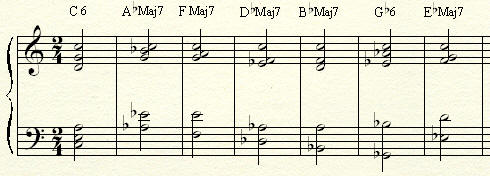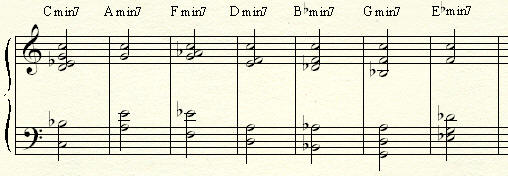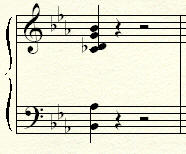Free Lessons
Introduction to chord substitutions (Part 2)
I was planning to go on to something else this week. However, during the past week, I have heard from several people asking me about the chord chart that I provided last week. Some questioned whether you can really use all of those chords when you have a C as the melody note.
Below I am going to give you a way to play every single one of those chords with a C as the melody note. However, before I do, I want to discuss a few other things about chords.
First of all, you should know that I am going to stick with a practical discussion of chords. If you asked a music theory expert how many possible chords there are, you would probably get a huge number. But what he/she might not tell you is that the same chord is named differently in different situations. There are
actually fewer chords than you might think.
Here is an example of what I mean. If you took a theory class, you might hear about an augmented 6th chord called the “Italian 6th.” From a practical standpoint, there is no need for that complexity because the Italian 6th looks exactly like a dominant chord.
Perhaps you have heard of polychords, meaning two different chords played at the same time. Sounds complicated, doesn’t it? But in reality, polychords are
usually just extended chords, meaning chords with 9ths, 11ths, and 13ths. If you look at it from that prospective, polychords are no big deal.
So what you need to understand is this. If you can master the sorts of chords that I will show you below, you will be playing chords that are about as good as they get in Western music. That should make you feel a bit better.
Now, let’s run through the chart and I will show you ways to play all of those chords with a C as the melody note. If you sit down and play them on the piano, don’t be surprised if many of them sound bad when you play them alone. The way a chord sounds is all about its context. For simplicity’s sake, I am not going to list the color notes in the chord symbol, but there are obviously a lot of them being used.
Major and Major 7th chords

Minor and Minor 7th chords

Dominant

Half diminished and Full diminished

In case you don’t remember, throughout these lessons, I am notating half diminished chords as a minor 7th with a b5 (which is exactly what a half diminished chord is). Notice that I only list two fully diminished chords, but in reality, I could list many more. Keep in mind that a diminished chord is simply a series of
notes played a minor third apart.
As I have mentioned many times before, these chords can sound wonderful or horrible depending on the context. I would like to point out the Ab7 dominant chord from above–notice that there is a Ab in the left hand and a A natural in the right hand. Those close intervals are widely scattered throughout all these
chords, and they make the chords sound good. They are not misprints. In this case, the A natural is a flat 9–technically, I could and probably should write it as B double flat but I know most of us (including me) hate double flats.
Now, let’s examine one of these chords. Here is a great voicing for a chord when the melody note is the root. Play it by itself and listen to how horrible it sounds.

Now listen to this chord in a song and notice how magical it becomes. It is the third beat of the third measure.

Notice that this chord has six notes and five of them are unique–remember that we want to only double the melody note in most situations. This is a Bb7 chord with a flat 9th and a 13th. Now play the phrase again and change the G to Gb in the chord (you will be changing the 13th to a flat 13th). It is hard to choose which sounds better, but they both sound great.
My point is that those color notes make all the difference. So, start looking for ways to add them. And no, don’t expect it to happen overnight. Bear with me and I will get back to this topic in a few months.
Practice Strategy:
You are going to learn how to substitute chords by doing it–a lot. Pick a hymn and start playing. Avoid playing any chord as it is written. Either add color notes or try changing it completely. Experiment with the step-wise bass pattern or pedal point bass to force yourself into thinking more broadly.
